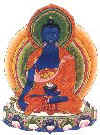|
|
||||
|
Tibetan
Medicine - Tibetan
medicine - How
Maha
Kumbh
Heritage
- Ritu
Kumar - Designing
Exhibition
|
|
|
||
|
the-south-asian.com January 2001 |
||||
|
Page 3 of 3
Tibetan Medicine -
How and Why it Works (continued) Diagnosis of Nyipa sum when imbalanced There are three methods of diagnosis through:
Observation is done by urine analysis and looking at the tongue. A sample of urine must be the first early morning urine of the patient. Spicy foods, alcohol and sexual intercourse should be avoided on the night prior to providing the urine sample. In Tibetan medicine urine analysis is divided into eight sections; the physician examines the colour, vapour, odour, bubbles, sediments and albumin of the urine. The colour of the urine is determined by the intake of food and drink, seasons and diseases. The rLung patient's urine is
clear like water and has large bubbles. When observing the tongue, the rLung
patient has a very red, dry and rough tongue. The mKhris-pa patient's
tongue is yellow with a thick coating. The second method of diagnosis is by reading the pulse. In Tibetan medicine pulse reading is divided into thirteen sections. For the Tibetan physician the art of pulse reading provides an invaluable source of information because the pulse is like a messenger between the doctor and the patient. To read the pulse it is very important for the patient to be as rested as possible. The physician places the index, middle and third fingers on the radial arteries. The space between each of the three fingers is the width of a grain of rice, and the fingers are placed half an inch from the crease of the wrist. The physician uses both hands to examine the pulse; the left wrist of a male patient is read first, whilst for the female patient it is the right wrist which is read first. The third and final method of diagnosis is by questioning - asking the patient how and when the problem started, its location and the type of food that harms or helps them. Treatment The fourth and final category is about the treatment of the patient. There are four methods of treatment:
Diet: If the illness is
not serious advice is given regarding diet and behaviour. Generally the rLung
patient must try to eat food that has heavy and nutritional potency, such as
lamb, butter, molasses, alcohol, milk, soups, chicken, garlic, ginger and
onions. Behaviour:
The rLung patient should stay in dark and warm places, the
surroundings should be very quiet, and the surrounding views should be
beautiful . The patient should have good company such as that of lovers and
close friends. The patient should also rest both physically and mentally
without any worries. Medicines: The third
method of treatment is the prescribing of medicine. It can be administered
in various forms such as decoction, powder, pills etc. For the rLung
patient various herbal ingredients are used such as aqullaria agollocha,
allium sativum, myristica fragrans, asafoetida, santalum album etc. Surgery: The final method of treatment is surgery - divided into mild and rough. Mild surgery for the rLung patient includes massage with year-old butter and oily compresses. Rough surgery for the rLung patient is placing moxa on the selected points of rLung; these are on the crown of the head, the first, fifth and sixth vertebrae of the spinal cord, the sternum, etc. For the mKhris-pa patient mild surgery is sitting beneath waterfall and mild purgatives. Rough surgery for the mKhris-pa patient is blood letting and cupping. For the Bad-kan patient mild surgery is hot fermentations, saunas and mild emetics. Rough surgery for the Bad-kan patient is golden needle therapy and the application of heated surgical stylets. Conclusion All diseases and illnesses can be categorised within the Nyipa sum - rLung, mKhris-pa and Bad-kan. Similarly, with all these different types of disease and illness there is no other location for them than the seven bodily sustainers and the three eliminating functions. In Tibetan mdicineor the science of healing, we always treat the cause or the root of the disease and illness and not the symptoms. In the medical texts there is the following example -without treating the root or the cause of the disease it is the - as having a poisonous tree and just cutting off the leaves and branches without pulling it up from it's roots. If you just cut the leaves and branches it will still continue to grow. The Medicine Buddha says that if the physician treats the patient according to the medical texts the treatment will be beneficial. If the method of treatment fails, it is not the fault of the physician but the fault of the Medicine Buddha himself. This shows us how confident and sure the Medicine Buddha was about the medical texts. However, if a person is suffering from a chronic disease and expects a quick solution, this is not possible. He will have to be patient and take the medicine for a long period of time before its positive results will show. ___________ (Courtesy The Office of Tibet, London) info@tibet.com
____________________ H.H. The Dalai Lama on Tibetan medicine - Tibetan medicine - How and Why it works
|
||||
| Copyright © 2000 [the-south-asian.com]. Intellectual Property. All rights reserved. | ||||
| Home |
